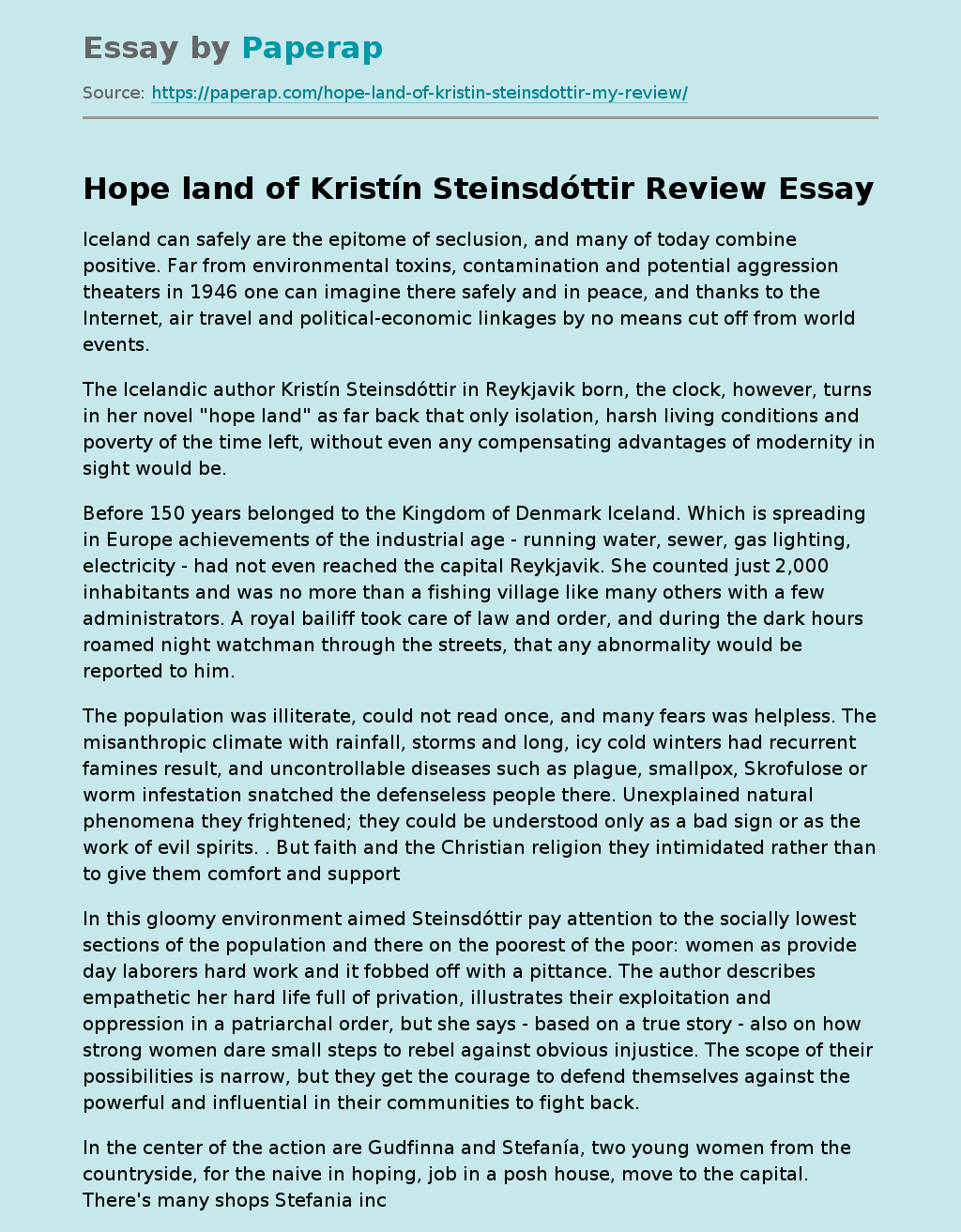“Hope Land” of Kristín Steinsdóttir
Iceland can safely are the epitome of seclusion, and many of today combine positive. Far from environmental toxins, contamination and potential aggression theaters in 1946 one can imagine there safely and in peace, and thanks to the Internet, air travel and political-economic linkages by no means cut off from world events.
The Icelandic author Kristín Steinsdóttir in Reykjavik born, the clock, however, turns in her novel “hope land” as far back that only isolation, harsh living conditions and poverty of the time left, without even any compensating advantages of modernity in sight would be.
Before 150 years belonged to the Kingdom of Denmark Iceland. Which is spreading in Europe achievements of the industrial age – running water, sewer, gas lighting, electricity – had not even reached the capital Reykjavik. She counted just 2,000 inhabitants and was no more than a fishing village like many others with a few administrators. A royal bailiff took care of law and order, and during the dark hours roamed night watchman through the streets, that any abnormality would be reported to him.
The population was illiterate, could not read once, and many fears was helpless. The misanthropic climate with rainfall, storms and long, icy cold winters had recurrent famines result, and uncontrollable diseases such as plague, smallpox, Skrofulose or worm infestation snatched the defenseless people there. Unexplained natural phenomena they frightened; they could be understood only as a bad sign or as the work of evil spirits. But faith and the Christian religion they intimidated rather than to give them comfort and support.
In this gloomy environment aimed Steinsdóttir pay attention to the socially lowest sections of the population and there on the poorest of the poor: women as provide day laborers hard work and it fobbed off with a pittance. The author describes empathetic her hard life full of privation, illustrates their exploitation and oppression in a patriarchal order, but she says – based on a true story – also on how strong women dare small steps to rebel against obvious injustice. The scope of their possibilities is narrow, but they get the courage to defend themselves against the powerful and influential in their communities to fight back.
In the center of the action are Gudfinna and Stefanía, two young women from the countryside, for the naive in hoping, job in a posh house, move to the capital. There’s many shops Stefania incite enthusiasm, and she even dreams of being able to catch a rich man. But such pipe dreams crumble before the two provided to it.
You must be glad to be able to rent a place to sleep in the humble abode of the carpenter Porfinnur and his wife Margrét. Day after day they hire themselves out for lowest services. They drag vats full of dirty laundry to the hot springs, heavy ship coal sacks from the ships to warehouses, dry and salted fish on large supporting frameworks, bring fresh water into the houses and dispose of toilet bucket. Accidents are on the agenda. A child falls in the hot springs, another freeze to death in a snowstorm.
Gudfinna and Stefanía are not the only ones to survive with such little value work. Everywhere they meet old people, maids and children, as they are dependent on the measly income. Only when animals are slaughtered – what happens rarely enough – we must hope that perhaps falls on top of a piece of black pudding. According sharp the daily struggle is for every order. you meet at dawn not among the first at the water source is a stand must be long queue. While men take out the right to displace the weaker from their seats. The tone is rude same everywhere. But in times of need, the women stand together.
The two protagonists complement each other perfectly. The fun-loving, curious and always frohgemute Stefanía conquered easily the hearts of all, it causes you to laugh together, to sing and dance, and can thus solve the depressed mood of the enslaved women, at least for a few moments.
On the other hand Gudfinna is a taciturn Eigenbrötlerin and attentive, critical observer. What a harrowing poverty all torments, let the simple material desires of women guessed: a blanket, a kerosene lamp … yet are less fulfilled their need for a little more justice, a little heat, a little bit of luck. In view of the misery of being overwhelmed, exploitation and indifference around them grabs Gudfinna desperate rage, but she is also taking initiative and responsibility, provides the majority of influential men brave forehead. As Stefania’s health is severely damaged, she takes her work and gets a herbalist to help.
In moments of greatest despair sings Gudfinna with a song she knows from her mother, courage. This is the “land of hope”. Can it like they do give hope to people, then?
Many Icelanders are drawn to America, even though they hardly know about it when it’s there to be many large street lamps. More and more rural poor come to the capital and lodging themselves in equally poor relatives until the next ship arrives and brings them to Canada. One day going on for Gudfinna a chance of their own lives and to change the women in their communities for the better. Courageously she wants to access. But it would violate it against rules.
Kristín Steinsdóttirs historical novel (Anika Wolff has it translated from the Icelandic) convinced, despite the simplicity of its plot and character development through gritty realism, detail and vividness of his descriptions. It paints a depressing, certainly authentic picture of that time and uses a skin-tight personal perspective. The impression of immediacy arises not least because of the simple linguistic form. The simple everyday vocabulary and short, often elliptical sentences look as if they entsprängen directly to the observing, waking consciousness of the characters.
“Hope Land” of Kristín Steinsdóttir. (2019, Nov 18). Retrieved from https://paperap.com/hope-land-of-kristin-steinsdottir-my-review/

